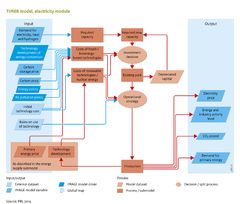Energy conversion: Difference between revisions
Jump to navigation
Jump to search
No edit summary |
No edit summary |
||
| Line 6: | Line 6: | ||
|IMAGEComponent=Energy supply and demand; Energy demand; Energy supply; Land use allocation; Climate policy; Drivers | |IMAGEComponent=Energy supply and demand; Energy demand; Energy supply; Land use allocation; Climate policy; Drivers | ||
|KeyReference=Hoogwijk et al., 2007; Hendriks et al., 2004; | |KeyReference=Hoogwijk et al., 2007; Hendriks et al., 2004; | ||
|InputVar=Technology development; Energy policies; | |||
|FrameworkElementType=model component | |FrameworkElementType=model component | ||
|Description=Primary energy sources are usually converted into more easily useable secondary energy carriers before they are used. Examples of such conversion processes are the production of electricity and hydrogen, but also the production of oil products from crude oil in refineries, and the production of final energy carriers from biomass. Historically, it can be noted that an increasing fraction of energy use is converted in complex processes, such as power and hydrogen production. This trend is driven by changes in the demand for energy services (e.g. more use of appliances), but also by the relatively ease of electricity for several end-use services. Both electricity and hydrogen are produced by the conversion of primary energy carriers such as fossil fuels, fissile materials (uranium), and the various renewable energy sources. Studies on transitions towards more sustainable energy systems tend to show the importance of these sectors. Key policy questions are: | |Description=Primary energy sources are usually converted into more easily useable secondary energy carriers before they are used. Examples of such conversion processes are the production of electricity and hydrogen, but also the production of oil products from crude oil in refineries, and the production of final energy carriers from biomass. Historically, it can be noted that an increasing fraction of energy use is converted in complex processes, such as power and hydrogen production. This trend is driven by changes in the demand for energy services (e.g. more use of appliances), but also by the relatively ease of electricity for several end-use services. Both electricity and hydrogen are produced by the conversion of primary energy carriers such as fossil fuels, fissile materials (uranium), and the various renewable energy sources. Studies on transitions towards more sustainable energy systems tend to show the importance of these sectors. Key policy questions are: | ||
Revision as of 17:39, 8 August 2013
Parts of Energy conversion
| Component is implemented in: |
|
| Related IMAGE components |
| Projects/Applications |
| Models/Databases |
| Key publications |
Key policy issues
- What is the potential role of energy conversion sector, particularly in power production, in achieving a more sustainable energy system?
- What are the potential roles of individual technologies, such as carbon capture and storage (CCS), nuclear power, hydrogen and renewable energy?
Introduction
"model component" is not in the list (driver component, pressure component, interaction component, state component, impact component, response component) of allowed values for the "FrameworkElementType" property.
